Authentic Citrine: The Gemstone of Light and Warmth
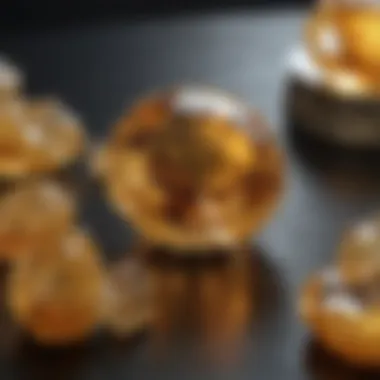
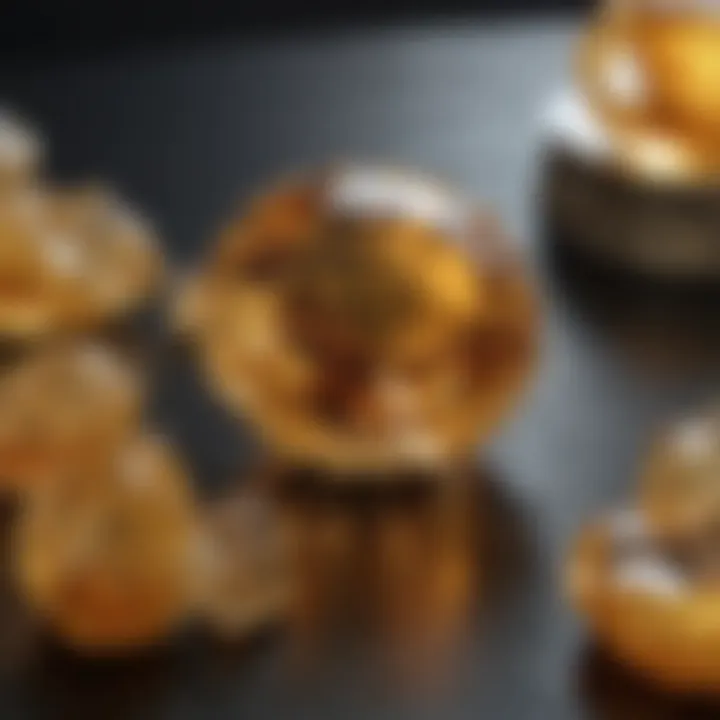
Intro
Citrine, often referred to as the stone of light and warmth, has captured the imaginations of many throughout history. Its golden hues evoke feelings of joy and positivity, making it a sought-after gemstone in various circles, from jewelry designers to crystal healers. This article aims to shed light on authentic citrine, diving into its origins, unique characteristics, and cultural significance.
As we journey through the fascinating realms of this gemstone, we will explore its geological roots, nuances in appearance, and tips for discerning genuine citrine from its imitations. Whether you are an avid collector, a jewelry designer looking for inspiration, or simply curious about this radiant gemstone, you'll find valuable insights in the following sections.
Gemstone Overview
Definition and Origins
Citrine is a variety of quartz, a mineral known for its abundance in nature. The name 'citrine' comes from the French word citron, meaning lemon, which aptly describes its vibrant color. This striking gemstone typically forms in igneous rocks, such as granite, or in sedimentary deposits. Most sources of natural citrine are found in Brazil, Madagascar, and the Soviet Union.
Interestingly, citrine can arise from heat-treated amethyst, a process that enhances its yellow to orange shades. This transformation takes what could have been a lesser stone into something decidedly more desirable. It's essential to know which gemstones are treated, as this distinction can impact market value and authenticity.
Historical Significance
Throughout history, citrine has held a special place in various cultures. The ancient Greeks valued the stone for its beauty and durability, often using it in intaglio carvings. In the Middle Ages, people believed citrine could provide protection against negative energy, and it was worn as a talisman.
In more modern times, the stone’s significance has not diminished. It is embraced in many alternative healing practices, where it is said to promote happiness and clarity. Moreover, its association with the solar plexus chakra links it to personal power and self-expression. As we can see, citrine has traveled through time and retains its charm and mystical qualities.
Gemstone Properties
Hardness and Durability
Citrine is ranked at a 7 on the Mohs hardness scale, making it a relatively hard stone, yet it requires caution, as it can be scratched or damaged if not handled carefully. Its durability makes it suitable for various types of jewelry, from rings to pendants, allowing the wearer to enjoy its beauty without constant worry over its fragility.
Color and Clarity
The most striking aspect of citrine is its color range, stretching from pale yellow to deep orange, and even brownish tones in some cases. The clarity of authentic citrine can vary as well; ideal examples will appear transparent and free from inclusions. When examining citrine, it's beneficial to hold it up to the light to fully appreciate its vibrant hues and sparkle.
Remember: Authentic citrine should be rich in color and possess a crystal-clear quality. Any signs of cloudiness or excessive inclusions may indicate a lower-quality stone or a synthetic variant.
The End
In this overview, we have laid the groundwork for understanding the essence of authentic citrine—the nature of its origins and the richness of its history provide a backdrop for its value today. As we continue, we will delve deeper into identifying genuine citrine, its market valuation, and the fascinating role it plays in contemporary culture and practices.
The Geological Origins of Citrine
Understanding the geological origins of citrine serves as the foundation for appreciating this remarkable gemstone. The formation process determines not just the physical traits of citrine, but also its intrinsic value and rarity in the gemstone market.
Formation Process
Citrine, a member of the quartz family, undergoes a unique formation process that sets it apart from its crystalline relatives. Its color—that sunny yellow to golden hue—arises primarily from the presence of iron during the crystal's development. This process occurs deep within the Earth's crust, where silica-rich fluids seep into the cavities of existing rock. As these fluids cool and crystallize, citrine begins to form.
Interestingly, while citrine can occasionally occur naturally, much of the citrine on the market today is actually heat-treated amethyst or smoky quartz. This treatment typically enhances the color, making it more vibrant and appealing. The transformation from amethyst to citrine happens when exposed to high temperatures, often in a controlled environment.
Global Sources
Citrine is found in various locations around the world, and these global sources contribute to both the gemstone’s variety and availability. Some of the most notable places include:
- Brazil: The largest producer of natural citrine, especially from the Minas Gerais region. The stones here showcase beautiful and bold yellow shades.
- Spain: Known for its deep colored citrine, often featuring unique inclusions.
- Africa: Specifically, countries like Madagascar and Zambia produce stunning specimens of citrine that are increasingly popular.
- Russia: This country has historically been recognized for its fine-quality natural citrine, known for lighter tones.
The sourcing of citrine from these regions illustrates its depth and variety, each location imparting its character to the gemstones produced. The geographic diversity underscores why different citrine pieces can display varying shades and clarity, enhancing both their aesthetic appeal and the narrative of their formation.
The geological origins of citrine not only tell a story of immense natural processes but also emphasize the transformative journey from Earth to adornment, enriching the understanding of this radiant gemstone.
Physical Properties of Authentic Citrine
Understanding the physical properties of authentic citrine is crucial for gemstone enthusiasts and collectors alike. These properties not only help in identifying genuine citrine but also provide insight into its value, applicability, and aesthetic appeal. Authentic citrine, renowned for its warm, sunny hue, carries unique characteristics that dictate its usability in jewelry and decor. As you delve into this section, you will uncover the importance of color, clarity, and durability, crucial elements that set citrine apart from other gemstones.
Color Variations
The color of citrine can best be described as a vivid dance of yellow and orange, reminiscent of a sunbeam captured in crystal. This gemstone showcases a spectrum of shades, which can range from pale yellow to deep amber and even brownish-orange, which surfaces when iron impurities are present during formation. Understanding these color variations is vital for collectors, as they often dictate pricing and desirability.
- Pale Yellow: Often referred to as "lemon citrine," this shade is light and airy, making it suitable for delicate jewelry designs.
- Golden Yellow: The most sought-after hue, golden yellow is warm and vibrant, reflecting light beautifully.
- Dark Amber: This deeper tone resembles topaz and is valued for its richness and warmth, often favored in statement pieces.
The intensity of color can indeed indicate the quality of the gemstone. A well-saturated citrine can display remarkable saturation without being overly dark or muddy—a hallmark of authenticity.
Clarity and Transparency
When it comes to clarity, citrine is generally celebrated for its excellent transparency and lack of inclusions. A high-quality citrine possesses a clear, bold appearance, allowing light to pass through effortlessly. Inclusions, which are often created during the gemstone's formation, can impact its desirability and value. The clearer the stone, the more sought-after it becomes.
In fact, the most prized citrines exhibit:
- Flawless Clarity: These stones appear free from any visible markings under 10x magnification.
- Minimal Inclusions: While slight natural inclusions may be acceptable, an excess can detract from the stone's overall appeal.
- Brilliance: The way a citrine reflects light not only enhances its beauty but also adds to its allure in jewelry settings.
"A clear citrine is like a sunbeam caught in the palm of your hand. It holds warmth and light, drawing the eye to its radiant beauty."
Hardness and Durability
Citrine scores a respectable 7 on the Mohs scale of mineral hardness. This means it can withstand everyday wear and tear, often making it a practical option for rings, pendants, and bracelets. Its durability also stems from the fact that citrine is relatively resistant to scratches and breakage compared to softer stones.
When considering citrine for jewelry, these factors are essential:
- Resilience: Unlike more fragile gemstones, citrine can endure daily use, making it an excellent choice for pieces that are worn frequently.
- Care Requirements: Although sturdy, citrine still benefits from protective settings and reasonable care to maintain its clarity and brilliance.
- Potential Treatments: Recognizing that some citrines may undergo treatments to enhance color or clarity can also affect how one perceives its durability.
In summary, the physical properties of authentic citrine—ranging from its vibrant colors to its clear, robust nature—are central to understanding its allure and value in the gemstone market. By recognizing these attributes, enthusiasts can better appreciate this gemstone's unique charm and make informed decisions when purchasing or collecting.
Historical Significance of Citrine
Citrine holds a special place in the tapestry of history, entwined with the developments of ancient civilizations and their spiritual practices. Its appeal goes beyond mere aesthetics; it's steeped in rich cultural narratives that shed light on how it was perceived and utilized throughout ages. Understanding citrine’s historical significance offers insight into not just the gemstone itself, but also the societies that cherished it, providing context for its lasting impact today.
Citrine in Ancient Cultures
Throughout different epochs, citrine was embraced by numerous ancient cultures, each attributing its unique warmth and color with various meanings and uses. For the Egyptians, citrine was often linked to the sun, believed to carry solar energy that could harness vitality and illumination. They would sometimes carve it into amulets to protect against evil spirits, a practice that exemplifies its importance in everyday life.
The Romans, on the other hand, appreciated citrine for its exquisite appearance. They adorned their jewelry with this vivid stone, crafting it into intricate designs. Not only did the Romans celebrate its beauty, but they also considered it a stone of eloquence, enhancing communication and persuasive abilities. Many politicians would sport citrine rings, believing it would bolster their oratory skills in public speaking.
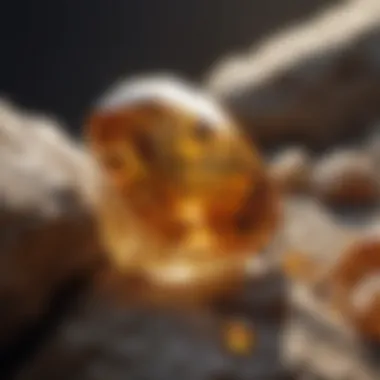
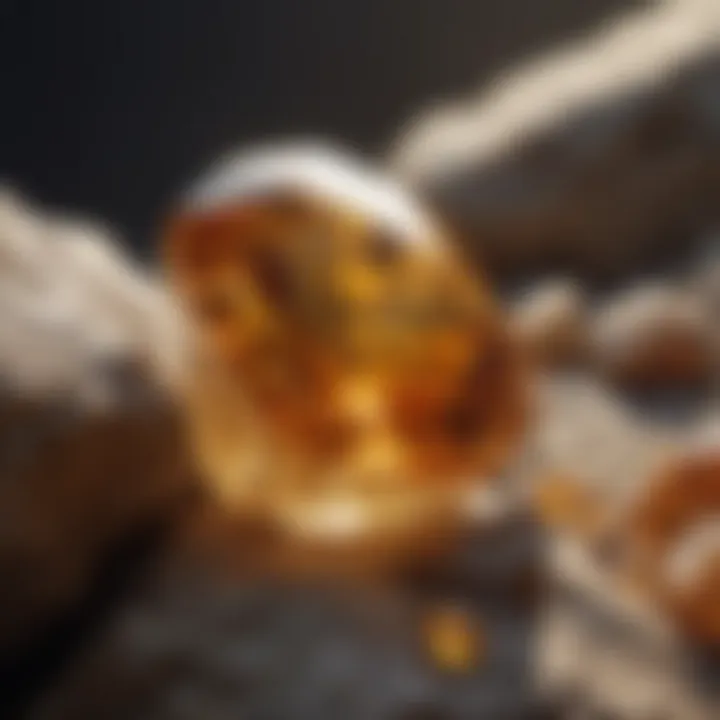
In the East, particularly in parts of India, citrine has roots in Ayurveda. It was revered not just as a decorative gem but as a healing stone, used to balance energies and bring clarity of thought during meditation sessions. The vibrant hue was thought to symbolize prosperity, thus elevating its status further as a gemstone of abundance.
Symbolism and Folklore
Citrine is not just a pretty face; it’s layered with meanings that have evolved over countless generations. In folklore, it has often been dubbed the "Merchant’s Stone" because of its association with wealth and prosperity. There’s a belief that keeping citrine close or in one’s wallet attracts business ventures and financial success. It was commonplace for traders to carry it as a good luck charm during transactions, helping them seal favorable deals.
Additionally, the name "citrine" itself stems from the French word for lemon, a nod to its yellow hue, which infuses joy and positivity into various narratives surrounding it. The notion that citrine carries the energy of the sun only amplifies these ideas, offering a symbolic representation of hope and happiness. In various cultures, this gemstone has been woven into tales where it transforms not just the physical but the emotional landscape of individuals.
Another powerful tale is that of citrine being seen as a protective stone against negative energies. Many believe it can dispel anger and fear, acting like a beacon of light in challenging times. From medieval Europe to modern-day workshops, citrine has been considered a fortifying presence to fortify the heart and mind.
In summary, the historical significance of citrine is vast and multi-dimensional. From its acceptance in ancient practices to its symbolic meanings, this gemstone continues to resonate with people today. Understanding these roles not only deepens our appreciation for citrine but also highlights the intertwined nature of culture and stone, revealing a narrative that is as rich and complex as the gemstone itself.
Authenticity in the Gemstone Market
When delving into the fascinating world of citrine, the concept of authenticity cannot be overshadowed. In a market flooded with imitations and treatments, it's crucial to discern what genuinely constitutes authentic citrine. The value of a gemstone, its physical properties, and its energy attributes are all tied intricately to its authenticity, which makes this topic not just relevant but essential for collectors, jewelry designers, and enthusiasts alike.
Why Authenticity Matters
Authenticity plays a significant role in establishing trust in the gemstone market. Natural citrine, originating from the earth, is often perceived as more desirable than its treated or synthetic counterparts.
For those vested in their jewelry or crystal collections, acquiring genuine citrine can be seen as an investment. The importance is twofold:
- Value Retention: Genuine gemstones typically appreciate over time.
- Energetic Integrity: Many believe in the purported metaphysical properties of authentic stones; therefore, having the real deal is paramount for those seeking specific energies or effects.
Identifying Genuine Citrine
Knowing how to identify authentic citrine can be a continuous learning experience. Here are some tips to ensure you are getting the real McCoy:
- Color Examination: Authentic citrine ranges from a pale yellow to deep orange. Be wary of overly vibrant hues that might suggest artificial coloring.
- Visual Clarity: Inspect for any inclusions. Genuine citrine might contain minor inclusions that could indicate its natural origin.
- The Scratch Test: Citrine is a 7 on the Mohs scale of hardness. If another stone scratches it, it might not be citrine.
- Refraction Testing: Using a refractometer can help determine the gem's refractive index, which aligns with citrine's unique properties.
By honing in on these identifiers, potential buyers can make informed decisions without falling into the trap of scams or sales tactics that might mislead them.
Natural vs. Treated Citrine
The distinction between natural and treated citrine is also a focal point when considering authenticity. Understanding the difference can significantly impact the buyer's journey.
- Natural Citrine: This form is harvested directly from geological formations. Its beauty is unaltered, offering true brilliance and energy.
- Treated Citrine: Often, amethyst is heated to achieve the yellow hue characteristic of citrine. While treated stones can still be beautiful, their value is considerably less than that of their natural counterparts.
Recognizing these differences not only influences purchasing decisions but also affects the appreciation of the stone's true nature.
"In the world of gemstones, the allure of natural beauty often far outweighs the appeal of enhanced facets. Authenticity shines brightest."
In summary, navigating the gemstone market requires a discerning eye. Knowing how to identify genuine citrine and understanding the nuance between natural and treated forms can empower buyers to enrich their collections with authenticity. Whether for sentimental reasons or investment potential, the stakes are high in the sphere of citrine authenticity.
Metaphysical Properties of Citrine
Citrine is often dubbed as the gemstone of light and warmth, not only for its delightful hues but for the metaphysical qualities associated with it as well. In the realm of crystal enthusiasts and alternative healers, citrine is seen as a source of positive energy, believed to channel vitality and creativity. Understanding the metaphysical properties of citrine serves as a bridge for those exploring its potential benefits, rooting its significance beyond mere aesthetics.
Common Beliefs and Uses
The beliefs surrounding citrine are as diverse as its color spectrum. Many people regard it as a stone of abundance, a tool to manifest prosperity and financial success. A common belief is that carrying or wearing citrine can help attract wealth—some folks even place it in their cash registers or wallets to boost business transactions.
- Energy Amplifier: Known to amplify energy and intentions, citrine resonates with the solar plexus chakra—a center associated with personal power and confidence. This feature promotes self-esteem and encourages a proactive mindset.
- Emotional Clarity: Many practitioners advocate that citrine can assist in dispelling negative emotions such as fear and doubt, instead promoting feelings of joy and positivity. The uplifting properties make it a favored choice for those experiencing moments of stress or uncertainty.
- Creative Inspiration: Artists, writers, and innovators frequently turn to citrine to unlock their creativity. Whether through meditation while holding the stone or keeping it nearby during work hours, it is thought to help stimulate fresh ideas and take inspired action.
Citrine in Crystal Healing
In the practices of crystal healing, citrine holds a special place due to its purported ability to cleanse and empower. It's not merely a pretty gemstone; many believe its vibrational frequency can bring about substantial changes in one's life.
Crystal healers often employ citrine in various methods—be it worn as jewelry, used in meditation, or laid upon the body in healing sessions.
- Holistic Healing: Users cite a range of health benefits associated with citrine, claiming it can aid digestion, improve emotional balance, and support overall vitality. The idea is that its warm energy can catalyze recovery and promote well-being.
- Integration Techniques: People interested in leveraging citrine typically incorporate it into their daily routines. For instance, placing citrine geodes in a living environment is believed to brightening the atmosphere, fostering a space of comfort and joy.
- Meditative Practices: During meditation, citrine can be held in hand or placed on the third chakra to enhance visualization and manifestation practices. By focusing on one’s intentions with the stone, many feel they can better align with their inner desires.
"Citrine is without a doubt a robust resource in the realm of metaphysical properties, acting as a catalyst for personal growth and emotional healing."
As citrine continues to garner attention in spiritual circles, appreciation for its multifaceted uses persists. Each belief and practice associated with this vibrant stone enriches its narrative, affirming its role as a beacon of light in both personal and shared journeys.
Citrine in Contemporary Culture
Citrine has taken its rightful place in contemporary culture, emerging as more than just a beautiful gemstone. It symbolizes not only luxury but also a type of optimism reflective of modern values. In a world that often feels overwhelming, citrine conveys warmth and a sense of security. This section explores how citrine is woven into the fabric of today’s design and lifestyle choices, from radiant jewelry pieces to home decor accents.
Current Trends in Jewelry Design
Jewelry design has seen a significant resurgence of citrine, showcasing its vibrant, sunny hues. The modern aesthetic often favors naturalistic and organic forms, and citrine fits the bill perfectly. Its shades—from pale yellows to deep golds—add a burst of color to rings, necklaces, and earrings. Designers frequently combine citrine with metals like rose gold and yellow gold, creating pieces that exude warmth and elegance.
Styles such as bohemian chic and minimalist modernism are making waves, with citrine being an ideal stone for both movements. For instance, a delicate citrine pendant can complement a casual outfit beautifully, while a bold, statement citrine cocktail ring encapsulates luxury.
"Citrine's growing popularity reflects a desire for authenticity and positivity in our lives, infusing wearers with a sense of joy and light."
While many engage in the current trend of sustainable jewelry, citrine is also a favorable choice because many of its sources advocate for ethical mining practices. This aspect drives a conversation in contemporary culture about the choices we make when it comes to our adornments, urging a shift toward more mindful consumption.
Citrine in Fashion and Decor
Beyond jewelry, citrine has garnered attention in fashion and home decor. Designers incorporate this gemstone in textiles, accessories, and even art pieces to evoke an uplifting ambiance. In fashion, citrine colors are popping up in the latest collections, symbolizing vigor, playfulness, and creativity.
Home decor trends mirror these inclinations as well. Citrine-infused accents—like cushions, curtains, or artwork—are being used to brighten living spaces. The color yellow, inspired by citrine, is often associated with feelings of happiness and brightness; it’s no wonder homes are embracing warm tones to foster a positive environment.
Both casual and formal settings benefit from the incorporation of citrine. Dressing up a living space with vases of citrine crystals or using citrine-colored fabrics can transform the energy within a room.
In summary, as we navigate the fabric of contemporary culture, the role of citrine evolves continually, resonating with a broad audience. Whether in jewelry, fashion, or decor, citrine speaks to a collective longing for joy, clarity, and connection—definitely a stone that embodies the essence of modern living.
Market Insights for Potential Buyers
When it comes to purchasing citrine, understanding the market is nearly half the battle. With the demand for authentic gemstones on the rise, and a wide range of options available, knowing what to look out for can help buyers make informed choices. This section dives into key aspects of the market, from deciphering the often-confusing terminology around value to practical considerations for making purchases. After all, investing in citrine isn’t just about aesthetics; it’s about valuing quality and authenticity.
Understanding Market Value
Market value of citrine isn’t just a number; it involves a complex interplay of factors. To truly grasp this, one must consider several elements:
- Quality of the Stone: The grade of citrine can vary significantly. Factors such as color depth, clarity, and size all play a crucial role in determining its market price. Stones with vibrant yellows and oranges are generally more sought after than those that appear dull or pale.
- Source and Provenance: Where the citrine was mined can lend it both value and character. For instance, citrine from Brazil is often viewed as superior when compared to those extracted from other locations.
- Market Demand: Like any market, the demand for citrine can fluctuate, which can directly affect its price. Keeping an eye on trends in jewelry design can inform buyers when to invest. A surge in the popularity of earthy tones in fashion could lead to increased interest in citrine pieces.
Buying citrine can feel overwhelming due to the abundance of options. However, knowledge is power. Being aware of these factors gives buyers the upper hand and makes it possible to spot good deals.
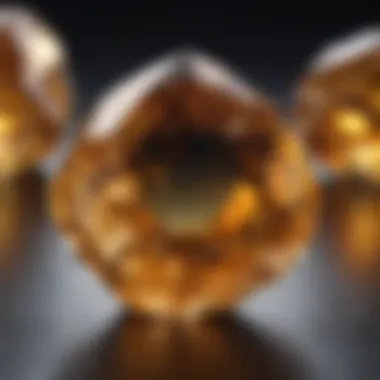
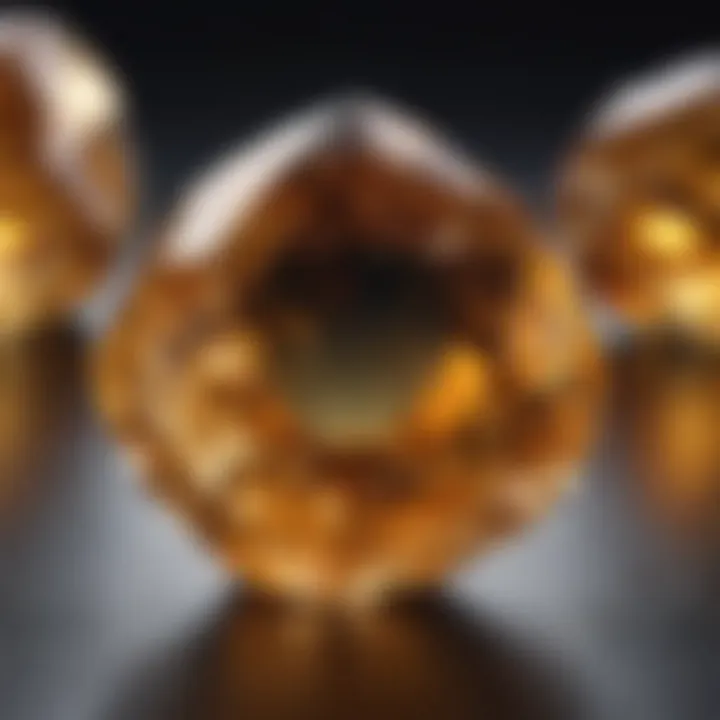
Key Considerations When Purchasing
Purchasing citrine is not just a matter of finding the prettiest stone at a good price. It involves careful thought and consideration to ensure a satisfying buying experience. Here are some essential considerations:
- Buy from Reputable Dealers: Whether online or offline, selecting a trusted dealer is paramount. Check reviews, ask for certifications, and don’t shy away from seeking recommendations from fellow gem enthusiasts.
- Examine the Gem Personally: If possible, inspect the citrine in person. Look for inclusions, color consistency, and overall craftsmanship if it’s set in jewelry. This personal inspection can reveal flaws that may not be visible in photographs.
- Research Before Buying: Familiarize yourself with current market prices for various qualities of citrine. Websites like Wikipedia, and gem trade publications can provide invaluable insight into what constitutes a fair price.
- Consider Future Value: Think beyond the immediate purchase. Will this piece maintain its value over time? Will it be appealing to future generations? Choosing a high-quality stone with rich color could stand the test of time.
"A true gem enthusiast knows that the value of a stone is not just in its purchase price, but in the stories and memories it holds."
Knowing the market can greatly enhance your fishing experience. Taking the time to understand these elements can make a meaningful difference in your purchase. Ultimately, it empowers you to choose citrine pieces that resonate not only in appearance but also in enduring value.
Caring for Citrine
Caring for citrine is pivotal when it comes to maintaining its stunning appearance and vibrant energy. This beautiful gemstone, often associated with light and warmth, requires particular attention to ensure its longevity and brilliance. A well-cared-for piece of citrine can not only retain its luster but also amplify its metaphysical properties, enhancing its value both aesthetically and spiritually.
In crafting your own relationship with this gem, it’s essential to understand that citrine is quite hardy, but like any valuable item, it still requires a little love and care. Sad to say, neglect could lead to scratches or a dull surface, robbing it of its innate charm. Here’s how to keep your citrine glowing bright and your spirit soaring.
Cleaning Techniques
Keeping your citrine clean is crucial, and fortunately, it doesn’t have to be a laborious task. Regular cleaning can help maintain its shine and sparkle. Here are some effective cleaning methods that won’t subject your citrine to unnecessary wear and tear:
- Soapy Water Soak: Mix mild soap with warm water and use a soft cloth to gently buff the gem. Ensure to rinse well in cool water to remove any soap residue.
- Soft Brush: For deeper cleanings, consider using a soft-bristle toothbrush. Ensure it’s dry and gentle, so it doesn’t scratch the surface.
- Avoid Harsh Chemicals: Stay away from strong chemical cleaners or ultrasonic cleaners, as they can harm the stone’s finish.
It’s often recommended to clean citrine every few months, or whenever it starts to look a bit lackluster. Just a gentle touch goes a long way in keeping it radiant.
Storage Recommendations
When not being flaunted, proper storage of your citrine can be just as important as its cleaning regime. How you store your citrine can protect it from potential damages, such as scratches or exposure to elements that might dull its shine. Here are some key pointers for optimal storage:
- Separate from Other Jewelry: Store citrine pieces away from other gems and jewelry to prevent scratches. A dedicated box with soft compartments is ideal.
- Keep in a Fabric Pouch: If possible, wrap individual pieces in a soft cloth or place them in fabric pouches. This shields against dust and accidental bumps.
- Avoid Extreme Conditions: Storing citrine away from direct sunlight and extreme temperatures prevents discoloration and damage. Maintaining a stable environment is best.
"Well-cared-for citrine can become not just a beautiful piece of jewelry, but a cherished part of one’s personal energy arsenal."
By taking these steps—cleaning and appropriately storing your citrine—you ensure that it remains not just a beautiful adornment, but an enduring source of warmth and positivity. In doing so, you can fully appreciate all the benefits and joys that authentic citrine has to offer.
Citrine and Personal Energy
Citrine has often been celebrated for its vibrant energy, which many believe can impact personal vitality and wellbeing. This section delves into the unique relationship between citrine and personal energy, exploring how this gemstone functions not just as a physical adornment but also as a catalyst for emotional and spiritual growth. Its warm hues are not merely aesthetic but resonate on psychic levels, making it a staple for those seeking to enhance their personal energy.
Chakra Associations
Citrine is primarily associated with the solar plexus chakra, which is the third chakra in the body. This chakra governs personal power, confidence, and identity. By promoting energy flow to this area, citrine is thought to unlock potential and remove energy blockages, allowing for a clearer expression of one's true self. It can also have an effect on the sacral chakra, often linked to creativity and emotional balance.
- Solar Plexus Chakra: It helps to instill confidence and willpower, empowering individuals to take charge of their lives and act decisively.
- Sacral Chakra: By stimulating this energy center, citrine encourages creativity and emotional expression, crucial for artistic endeavors and interpersonal relationships.
Many practitioners of crystal healing recommend placing citrine on the solar plexus during meditation to harness its energizing properties. This practice may cultivate a sense of self-worth and encourage an optimistic view of the future.
Influences on Mood and Wellbeing
The mood-enhancing effects of citrine cannot be overlooked. Often referred to as a "merchant's stone," it is said to attract abundance and prosperity, but its benefits extend far beyond financial gains. The cheerful yellow tones can uplift the spirit, instilling a sense of joy and positivity in everyday life. People may notice improvements in the way they respond to stressful situations, moving from frustration to resilience more smoothly.
"Citrine does not just shine outward; it illuminates the spirit within."
Incorporating citrine into daily life, be it through jewelry or simply having a piece in one’s workspace, may lead to:
- Increased optimism and enthusiasm
- A more proactive attitude towards challenges
- Greater emotional clarity, helping individuals to express their feelings without fear.
In summary, the energies associated with citrine resonate on multiple levels, positively impacting personal energy and influencing mood. By connecting with this remarkable gemstone, individuals can foster an enriched emotional landscape, empowering them to navigate life with an invigorated spirit.
Legends and Anecdotes Surrounding Citrine
Citrine, often celebrated as the gemstone of light and warmth, is steeped in rich folklore and captivating stories that have transcended time. Its vibrant golden hue has inspired countless legends that speak to its significance beyond mere aesthetics. Understanding these tales provides insights not only into the gemstone's historical context but also into the cultural values and beliefs of various societies through the ages.
One of the most compelling aspects of citrine’s lore lies in its connection to mystical properties. Many cultures believed that wearing this gem could ward off negative energy and bring prosperity. Ancient Egyptians often wore citrine as a protective talisman. They revered it for its ability to harness the sun's energy, considering it a gift from the gods. Such narratives not only elevate citrine’s perceived value but also inspire respect towards the earth's natural resources.
Stories of Mysterious Properties
Over the centuries, many have recounted tales of citrine's seemingly magical attributes. One such story hails from medieval Europe, where citrine was said to possess the power of divination. A popular belief was that it could aid in unlocking one’s intuition, guiding the wearer through tough decisions. Many would place a piece of citrine under their pillows, expecting to receive prophetic dreams.
Another interesting anecdote comes from the realm of merchant traditions. Traders would carry citrine with them, believing it would ensure business success and attract wealth. Its sunny color was thought to attract prosperity, leading to its nickname, "merchant's stone." This lore has seeped into modern self-help practices, where citrine is promoted as a stone to manifest abundance.
"Citrine is more than just a beautiful stone; it's a legacy wrapped in stories and whispers of empowerment."
Citrine in Art and Literature
Citrine’s allure has not just captured the hearts of spiritualists; it also found its way into the works of artists and writers. Throughout history, artists have depicted citrine not only for its luminous beauty but for its symbolism. In literature, it often symbolizes warmth, joy, and positivity. For example, Shakespeare's work frequently referenced jewels that symbolized various human traits and emotions. Citrine, with its bright warmth, represented joyful moments and the possibility of a brighter future.
In contemporary culture, citrine often features in artworks that discuss themes of prosperity and spiritual growth. Artists choose it not merely for its visual appeal but for the deeper meaning it conveys. Citric hues in paintings can evoke feelings of optimism and cheer, drawing the viewer into an ethereal experience reflective of sunlight bathing the canvas.
The versatility of citrine is evident in its representation across various media—from poetry to visual arts—always serving as a reminder of hope and vitality. The stories surrounding this gemstone reveal a world where its beauty intertwines seamlessly with the human experience of connectivity and inspiration. Artists and writers continue to draw on these connections, ensuring that citrine remains an important motif in both cultural and artistic expressions.
The Role of Citrine in Alternative Therapies
Citrine holds a cherished position in various alternative therapies, resonating with those who seek not just aesthetic beauty but also metaphysical benefits. Its vibrant hue and reputed properties create a connection between the physical and ethereal realms. This section highlights key elements of its role, emphasizing its potential benefits and considerations.
Use in Energy Healing
Energy healing practices often draw upon the unique attributes of gemstones, with citrine being a favorite among practitioners. Known as a stone of abundance, citrine is believed to promote positive energy and attract prosperity. Many energy healers incorporate citrine in their sessions to aid in balancing the chakras, especially the solar plexus chakra. The yellow hue is thought to inspire confidence and enhance personal power.
When used during an energy healing session, citrine is said to help clear negative energies, allowing for a more harmonious flow of life force. Practitioners often place citrine stones on the body or surrounding them to create a conducive environment for healing.
"Citrine’s warm radiance is like a ray of sunshine, fostering positivity and uplifting spirits."
It's also common to see citrine used in crystal grids designed to channel abundance and success. By integrating citrine stones into these grids, users aim to magnify their intentions. As with any healing modality, the effectiveness of citrine can vary from person to person, but its appeal is widely acknowledged.
Integration with Other Crystals
Citrine's versatility allows it to blend well with a variety of other crystals, creating synergies that amplify its effects. For instance, combining citrine with amethyst can yield beneficial results; while citrine fosters warmth and success, amethyst is known for its calming properties. This combination can lead to a balanced state – promoting clear thinking while remaining grounded.
Some practitioners also favor pairing citrine with rose quartz, the stone of love. This duo is said to enhance feelings of self-love and acceptance, which can be truly empowering. The contrasting energies of these stones provide a holistic approach to emotional and spiritual health.
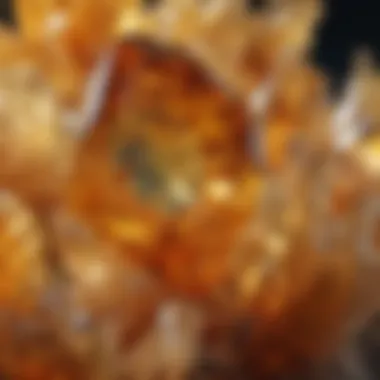
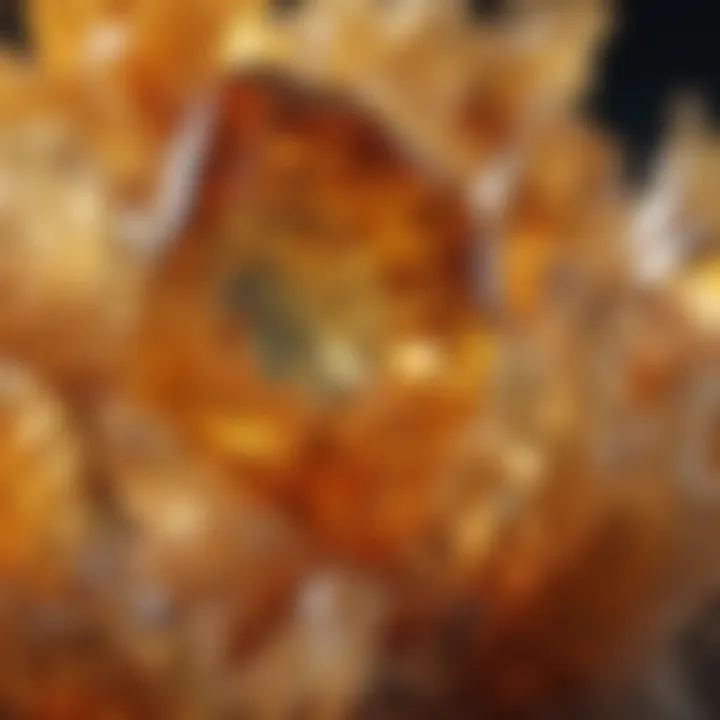
An important note when integrating citrine with other crystals is to ensure the energies do not clash. It’s wise to experiment with different combinations and observe what resonates most deeply. A well-thought-out arrangement can lead to remarkable outcomes in personal or group healing sessions.
Environmental Impact of Citrine Mining
The extraction of citrine from the earth brings to light not only the stunning beauty of this gemstone but also a set of challenges that arise from its mining. As awareness of environmental issues grows, understanding the impact of citrine mining becomes paramount. This section highlights the balance between enjoying the benefits of citrine and the responsibility we have towards our planet.
Sustainable Practices
Sustainable practices in citrine mining focus on minimizing environmental degradation while maximizing economic benefits. This involves adopting methods that ensure the extraction process does not severely impact the surrounding ecosystems. For example, miners can employ techniques such as selective mining, which reduces waste by only extracting the gemstones needed. Another approach is using water recycling in the mineral processing stages, lessening the amount of fresh water drawn from local sources.
Moreover, restoring mined areas is crucial. When mining sites are depleted, companies can engage in reclamation efforts, planting trees and native vegetation to rehabilitate the landscape. This not only helps in mitigating the impact of mining but also fosters biodiversity, allowing animals and plants to thrive once again.
Ultimately, these sustainable practices are not just ethical choices but also smart business decisions. They enhance brand reputation and meet the growing consumer demand for ethically sourced products.
Ethical Sourcing of Citrine
Ethical sourcing refers to procuring citrine gemstones in a manner that respects both the environment and the communities affected by mining operations. There's a clear call for transparency in the supply chain in recent years as buyers become more conscious of where and how their gemstones are sourced. Ethical sourcing considers several factors, including labor practices and community involvement.
When miners are treated fairly and compensated adequately, often they contribute to local economies, fostering growth and stability. Furthermore, many organizations have begun to certify mines that follow ethical guidelines, providing buyers with a stamp of approval to ease concerns about exploitation and environmental harm.
Regulatory standards are also starting to take shape. Gemstone certification bodies and NGOs are working hand in hand to pinpoint sources of citrine that adhere to strict ethical criteria. This helps in tracing the gemstone back to its origin, ensuring that it has been mined responsibly.
"With every piece of citrine, there’s a story behind it. Knowing that story allows us to appreciate its beauty and significance more fully."
Comparative Analysis with Other Gemstones
When diving into the world of gemstones, understanding how different stones stack up against each other—like a friendly contest—can illuminate the distinct qualities that each possesses. This comparative analysis of citrine with its counterparts not only sharpens our appreciation for citrine but also enhances our insight into the broader realm of gemstones. By examining both citrine’s unique traits and its similarities and differences with other popular stones, we can make more informed choices in purchasing, appreciating, and integrating these gemstones into our lives.
Citrine vs. Amethyst
Citrine and amethyst share a common genesis as they are both varieties of quartz. However, they diverge significantly in color and cultural symbolism.
- Color: Citrine shines in vibrant yellows and golden hues that evoke warmth, while amethyst dazzles with its rich purples, suggesting calmness and tranquility. This difference makes them suitable for varying moods and settings in jewelry design.
- Symbolism: Historically, citrine has been linked to prosperity and abundance. It is often termed the "Merchant's Stone". In contrast, amethyst is believed to promote clarity of mind and spiritual insight. The choice between the two may depend on personal beliefs or the energies one wishes to embrace.
- Physical Properties: They both boast a hardness of 7 on the Mohs scale, making them durable for everyday wear. However, the transparency of citrine tends to be a tad more pronounced, often seen sparkling brilliantly in sunlight, while some amethysts, depending on their quality, may have a deeper, sprawling color.
Overall, whether you're looking to attract wealth or seeking mental peace, both stones offer distinct advantages.
Citrine vs. Topaz
On the other hand, citrine and topaz dance to a different tune altogether, though both are firmly planted in the hearts of gemstone lovers around the world.
- Color Spectrum: Topaz comes in a plethora of colors—including blue, pink, and even colorless—while citrine does not strays far from its signature yellow-orange. This variety allows for greater creative freedom when designing or selecting pieces for personal adornment.
- Clarity and Presence: In terms of clarity, topaz can achieve remarkable transparency and brilliance, especially in its blue varieties. Citrine, while clear, often features more inclusions, giving it a warmer, earthier look.
- Cultural Significance: Citrine maintains its foothold in financial prosperity, while topaz is often associated with love and affection. This could sway someone's choice based on what energies or meanings they prioritize in their personal lives.
Citrine's Influence on Global Culture
Citrine, often referred to as the "stone of the merchant," holds a renowned place across various cultures due to its rich hues resembling sunlight and its reputed metaphysical properties. The significance of citrine in global culture spans a multitude of practices, beliefs, and artistic expressions, marking it as a noteworthy gemstone beyond mere aesthetics. Its warm color evokes a sense of positivity and abundance, drawing attention not just for its beauty but also for its purported benefits.
Citrine in Various Traditions
The presence of citrine in cultural traditions is as diverse as its shades, each with distinct meanings and uses, shaped by geographical and social influences. For instance, in Feng Shui, citrine is revered as a prosperity stone, placed in homes and businesses to attract wealth and success. Its vibrant color symbolizes vitality, making it a focal point in environments that seek to cultivate positive energy.
Citrine also finds its place in several ancient civilizations. The Greeks valued it for its supposed ability to protect against venom and harm. Similarly, Ancient Egyptians adorned themselves with citrine jewels, believing the stone offered protection and healing powers. The belief that citrine can enhance personal will and manifestation has led to its incorporation in various rituals aimed at personal growth and transformation.
In modern days, citrine continues to hold a firm position in the metaphysical community. Many holistic practitioners advocate for its use in meditation and crystal healing, emphasizing that citrine can promote clarity, creativity, and self-confidence.
"Citrine embodies the sun's warmth, often associated with wealth, abundance, and mental clarity across numerous cultures."
From fashion runways to home decor, citrine's appeal extends into contemporary aesthetics. Jewelry designers often use citrine in pieces that celebrate the stone's luminosity and warmth, creating items that not only captivate the eye but also carry deeper meanings influenced by their rich history.
Considerations surrounding citrine's cultural significance highlight the importance of understanding its origins and the narratives woven within various traditions. Whether it's the colorful jewelry pieces gracing the methods of artisans or healing practices resonating in spiritual circles, citrine's influence intertwines with countless aspects of life and belief, establishing it as a timeless and cherished gemstone.
Future Trends in Citrine Utilization
As we venture further into the 21st century, the world of gemstones, particularly citrine, is on the brink of exciting developments. Citrine, known for its cheerful hues and purported energizing properties, is not merely ornamental. Its application is being reimagined, creating ripples across various industries. This article explores the potential directions citrine might take, shedding light on both its technological advancements and innovative designs in jewelry making. Such insights are crucial for gemstone enthusiasts, collectors, and designers alike, all keen on staying ahead of the curve.
Emerging Uses in Technology
Citrine's versatility is becoming increasingly apparent in technological realms. Researchers are delving into the fascinating world of piezoelectric materials, where certain crystals can generate electric charges under mechanical stress. Citrine, particularly in its purest forms, has shown promise as a candidate for such applications.
- Optical Components: The transparency and refractive index of citrine position it as a potential player in optical technology. Innovations may incorporate citrine in laser systems or high-end optical lenses. Imagine a camera lens that not only delivers clarity but also infuses images with a warm, golden glow.
- Energy Applications: There’s an emerging interest in utilizing citrine in sustainable energy systems. Its unique properties could be harnessed in solar technology or energy storage systems, making citrine not just a beauty to behold but a component of cutting-edge technology.
"The potential of citrine stretches far beyond aesthetic appeal; it could soon power the future, both literally and metaphorically."
In addition to these fields, citrine could see advancements in wearable technology. Consider smart jewelry embedded with sensors, which could track health metrics while also providing the wearer with the comforting energy traits of citrine.
Innovations in Jewelry Making
The jewelry industry is also on the rise with citrine. Designers are pushing the envelope, integrating this radiant gemstone in ways that marry tradition and modernity. There are several noteworthy trends emerging:
- Unique Cuts and Settings: Jewelers are experimenting with unconventional cuts that highlight citrine's brilliant color and enhance luminosity. Instead of classic round or oval shapes, expect to see freeform cuts that allow for more creativity and an organic flow in designs.
- Mixed Media: Citrine is increasingly being paired with unconventional materials like resin, wood, and recycled metals. This fusion not only brings a contemporary edge to jewelry pieces but also appeals to eco-conscious consumers.
- Personalized Pieces: Customization is key in modern jewelry trends. Citrine’s associations with positivity and success lead to its use in personalized pieces, where individuals can select citrine to reflect their aspirations and personal journeys.
Just as citrine's warm hue brings a slice of sunshine into design, these innovations are redefining how gemstones are incorporated into jewelry. With every new piece, artisans are telling a story, weaving together history, craft, and emotion, all while ensuring citrine maintains its place as a symbol of light and warmth.
Concluding Thoughts on Authentic Citrine
In examining authentic citrine, we find ourselves not just observing a gem, but delving into its historical, geological, and cultural significances. This vibrant yellow stone embodies warmth and light, and its value extends far beyond mere aesthetics. As we summarized in previous sections, citrine's formation, physical properties, and metaphysical attributes create a compelling narrative that resonates with various audiences—from gemstone collectors to holistic health enthusiasts.
One of the key insights gained is the gemstone's versatility. Authentic citrine is not only appreciated for its beauty in jewelry but is also revered in many spiritual practices for its purported healing properties. Its connections with personal energy and chakra systems illustrate its role as more than just an ornamental piece; it serves as a tool for self-improvement and enlightenment.
Moreover, understanding the market dynamics associated with citrine gives buyers a clearer perspective on how to navigate options while ensuring authenticity. The differences between natural and treated citrine, coupled with effective identification methods, empower enthusiasts to make well-informed purchases.
"Citrine is more than just a jewel; it is a reflection of light—symbolic of clarity, positivity, and empowerment."
The environmental and ethical considerations surrounding citrine mining are crucial, too. Engaging with sustainable practices not only preserves natural heritage but also aligns with a broader moral responsibility.
In summary, the allure of authentic citrine lies in its rich tapestry of features that bridge nature, culture, and personal growth. By recognizing how citrine intertwines with various elements of life, we highlight its position as a beloved gem and cherished personal ally.
Summary of Key Insights
- Gemstone of Growth: Citrine isn't merely decorative; it holds spiritual significance, linking emotional and physical well-being.
- Market Awareness: Knowledge of citrine's authenticity is critical for consumers, ensuring good investments in gemstones.
- Ethical Awareness: The rise of sustainable practices in the mining industry shows a commitment to preserving both the environment and the community.
- Cultural Significance: Across numerous cultures, citrine holds stories that enhance its value, providing deeper connections to traditions and beliefs.
Encouragement for Further Exploration
As we've covered multiple facets of authentic citrine, from its geological origins to its cultural relevance, further exploration is encouraged. For those captivated by this gem's beauty and meaning, delving into its applications in art and literature can provide a fuller understanding of its impact. Additionally, the evolving technology and innovative approaches in gemstone crafting are worth keeping an eye on.
Engaging with community discussions on platforms like Reddit, or finding specialized groups on Facebook can spark inspiration and broaden perspectives. Dive deeper into crystal healing practices or explore regional mining practices to appreciate the gem's journey from earth to elegance.



